When it comes to keeping your motorcycle in top shape, neglecting maintenance can lead to serious issues down the road. You should start with some straightforward tasks, like checking your oil and tire condition. By being proactive, you not only enhance your bike's performance but also guarantee your safety. However, there are common pitfalls that many riders overlook, and addressing these can save you time and money. Curious about what these essential tips are and how they can make a difference? Let's explore the critical aspects of motorcycle maintenance together.
Key Takeaways
- Regularly check and maintain your motorcycle's oil levels, changing it every 3,000 to 5,000 miles for optimal performance.
- Inspect brake systems frequently, focusing on fluid levels, pad wear, and line integrity to ensure safety.
- Monitor tire pressure and tread depth regularly to avoid accidents and ensure proper handling.
- Keep the chain clean and lubricated every 300-500 miles to prevent wear and ensure smooth operation.
Understanding Ducati Common Issues
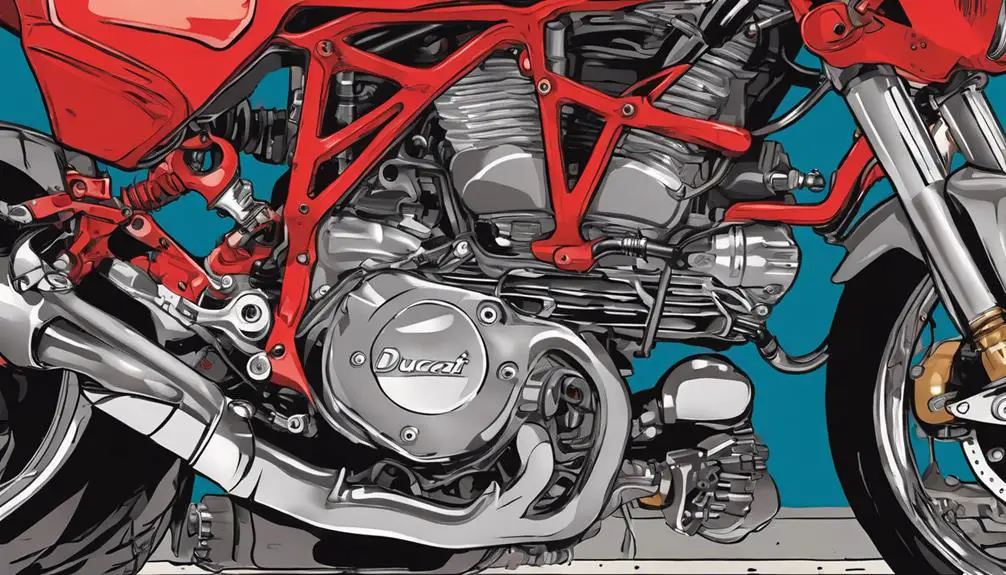
Ducati owners often encounter specific issues, so it's crucial to understand these common problems to keep your bike running smoothly.
One of the most frequent complaints involves electrical systems. You might notice flickering lights or a failing battery, which can hinder your riding experience. Regularly check connections and consider upgrading to a high-quality battery to avoid these headaches.
Another issue is the notorious heat management. Ducati bikes can run hot, especially in stop-and-go traffic. You'll want to monitor your coolant levels and inspect the radiator for leaks or blockages. Keeping your bike cool allows you to enjoy longer rides without worry.
Additionally, you may experience issues with the clutch. If you find it slipping or feeling spongy, it's time to check the fluid levels and inspect the clutch plates. Addressing these symptoms early can prevent more extensive damage down the road.
Essential Tools for Maintenance
To keep your motorcycle in top shape, you need the right tools at your fingertips. A basic tool kit is essential, but knowing about specialty tools can make your maintenance tasks much easier.
Don't forget to gear up with safety essentials to protect yourself while you work.
Basic Tool Kit
Having the right tools at your fingertips makes motorcycle maintenance simpler and more efficient. You don't need a massive toolbox to get started; just a basic tool kit will set you free to tackle most common tasks.
Begin with a set of metric and standard wrenches, as you'll often need both for various bolts. A quality socket set is also essential, allowing you to easily access tight spaces.
Don't forget a set of screwdrivers—both flathead and Phillips. These will help you with everything from adjusting mirrors to securing fairings. A pair of pliers, including needle-nose, can be invaluable for gripping and twisting.
You'll want a torque wrench to guarantee proper tightening, especially on critical components. A tire pressure gauge is another must-have; keeping your tires at the right pressure enhances performance and safety.
Finally, a good quality chain cleaner and lubricant will keep your drive system smooth and extend its life.
With this basic tool kit, you'll feel empowered to perform regular maintenance and repairs, allowing you to ride with confidence and freedom. Grab your tools, and embrace the open road!
Specialty Tools Overview
Specialty tools can make a considerable difference in your motorcycle maintenance routine, allowing you to tackle specific tasks with ease and precision. Investing in these tools not only enhances your skill set but also empowers you to take control of your ride's performance.
One essential specialty tool is the torque wrench. This tool guarantees you apply the correct amount of torque when tightening bolts, preventing damage and guaranteeing safety.
A chain alignment tool is another gem, helping you maintain ideal chain tension and alignment. This can greatly improve your bike's handling and longevity.
Don't overlook a valve adjustment tool, especially if you're dealing with high-performance engines. Properly adjusting valves can release your bike's full potential.
Additionally, a motorcycle lift or stand can elevate your ride, providing easier access to hard-to-reach areas for repairs and maintenance.
These tools are more than just gadgets; they're gateways to freedom. They enable you to maintain your motorcycle on your terms, fostering a deeper connection with your machine.
Safety Gear Essentials
Maintaining your motorcycle also means prioritizing your safety with the right gear, ensuring you're protected while working on your ride. You'll want to invest in a sturdy pair of gloves; they not only enhance your grip but also protect your hands from cuts and scrapes. A quality set of goggles or a face shield is essential too, keeping debris and harmful substances out of your eyes.
Don't forget a durable helmet. It's your first line of defense against head injuries, so choose one that fits well and meets safety standards. A long-sleeve shirt and sturdy pants can shield your arms and legs from hot engine parts or sharp edges. If you're feeling adventurous, consider wearing padded clothing for extra protection.
Lastly, a pair of steel-toed boots will safeguard your feet from heavy components and provide solid traction when you're working. Remember, the goal is to be comfortable and confident while tackling maintenance tasks.
Checking and Changing Oil
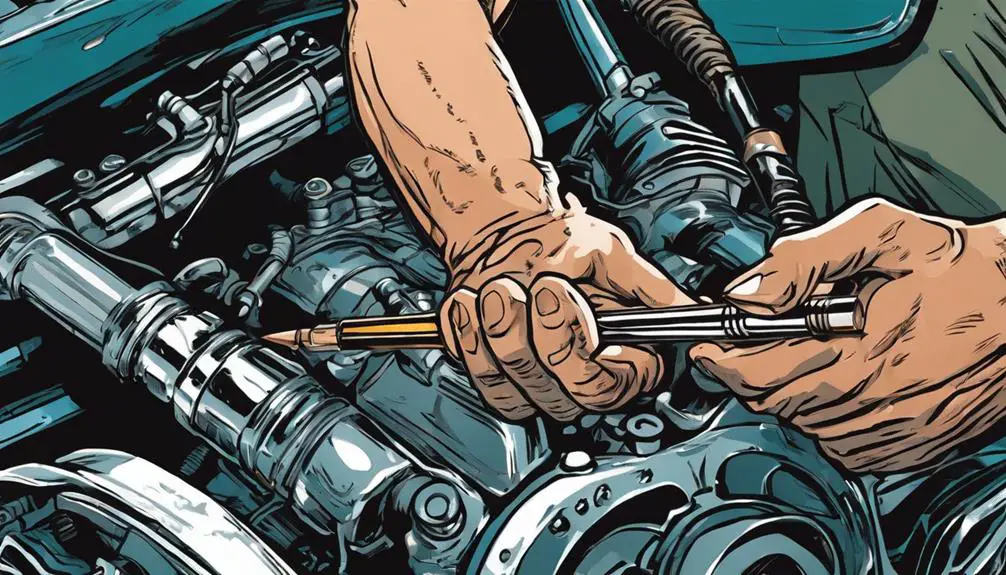
One of the most essential tasks in motorcycle maintenance is regularly checking and changing the oil to guarantee peak engine performance. You want your ride to feel liberated and responsive, and clean oil is key to that freedom.
Start by checking the oil level with your bike on a level surface. If it's low, add the recommended oil type—consult your owner's manual if you're unsure.
Changing the oil is equally important. Aim to do this every 3,000 to 5,000 miles, or as your bike dictates. First, warm up the engine to thin the oil, making it easier to drain. Then, position a drain pan under the bike, remove the drain plug, and let the old oil flow out completely.
Replace the oil filter while you're at it, ensuring you're using the correct one. Once everything's drained, replace the drain plug, and fill the engine with fresh oil. Again, refer to your manual for the right amount.
After a brief run, check for leaks and make sure the oil level is spot on. By taking these steps, you'll enjoy a smoother ride and keep your motorcycle in fighting shape. Embrace the freedom that comes with proper maintenance!
Inspecting Brake Systems
After verifying your oil is fresh and clean, it's time to focus on inspecting your brake systems to keep your ride safe and responsive.
Your brakes are your lifeline on the road, so don't overlook them. Start by checking the brake fluid level; it should be within the recommended range. If it's low, top it off with the right type of fluid.
Next, inspect your brake pads for wear. Look for any signs of thinning or uneven wear. If they're getting too thin, it's time for a replacement.
Finally, examine your brake lines for any leaks or cracks; a compromised line can lead to catastrophic failure.
Here's a quick checklist to guide you through the inspection:
- Check brake fluid level: Keep it topped off to maintain peak performance.
- Inspect brake pads: Replace them if they're worn down or uneven.
Tire Care and Maintenance
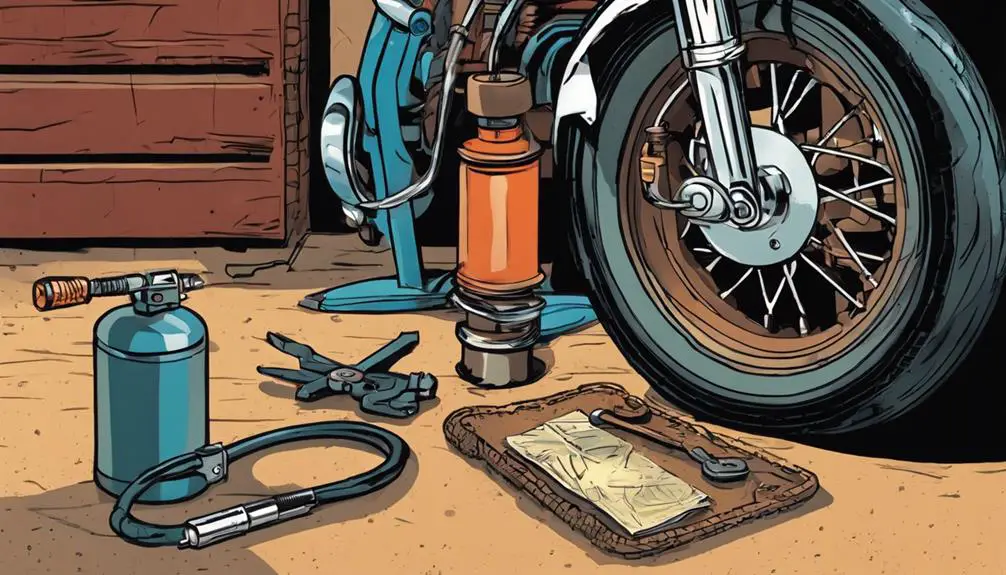
Taking care of your motorcycle tires is essential for your safety and performance on the road.
Regularly check your tire pressure and inspect the tread depth to make certain they're in good shape.
These simple steps can help you avoid accidents and extend the life of your tires.
Tire Pressure Checks
Regularly checking your motorcycle's tire pressure is essential for ensuring ideal performance and safety on the road.
It's not just about keeping that sleek ride looking good; it can make all the difference when you're out there chasing freedom.
Under-inflated tires can lead to poor handling and increased wear, while over-inflation might cause blowouts.
Here are some tips to help you stay on top of tire pressure checks:
- Use a reliable gauge: Invest in a good tire pressure gauge, as it'll give you accurate readings every time.
- Check when tires are cold: Tire pressure can rise with heat, so check it before you hit the road or after a long ride.
Tread Depth Inspection
Keeping an eye on your motorcycle's tread depth is just as important as monitoring tire pressure, as it directly impacts your grip and safety on the road. Your tires are your only contact with the asphalt, and worn-out tread can lead to hazardous situations, especially in wet conditions. You want to feel free and confident, not skidding and uncertain.
To check your tread depth, grab a tread depth gauge or use the penny test. Insert a penny into the tread grooves with Lincoln's head facing down. If you can see all of Lincoln's head, it's time to replace the tire. Aim for a minimum tread depth of 1/16 inch for ideal performance.
Don't forget to inspect for uneven wear patterns, as they can indicate alignment issues or improper inflation. Regularly rotating your tires can also extend their lifespan and guarantee even wear.
Taking a few moments to inspect your tread depth can greatly enhance your riding experience, giving you the freedom to ride with confidence. So, embrace the open road, but keep your tires in check to guarantee a smooth and safe journey ahead.
Electrical System Troubleshooting
Electrical issues can be frustrating, but with a systematic approach, you can effectively troubleshoot your motorcycle's electrical system.
Start by checking the basics. Make sure your battery is charged and connections are clean and tight. A weak battery can lead to all sorts of problems, so don't overlook this essential step.
Next, inspect your fuses. A blown fuse can cut power to critical components, leaving you stranded. Replace any fuses that are damaged, and keep extras on hand for emergencies.
Finally, examine your wiring. Look for frayed wires or loose connections, as these can cause shorts or intermittent failures.
Here are a few tips to guide you:
- Check the battery voltage: Use a multimeter to verify it's holding a charge.
- Test the starter relay: Listen for clicks when you press the start button; if you hear nothing, it may be faulty.
Chain Maintenance Techniques
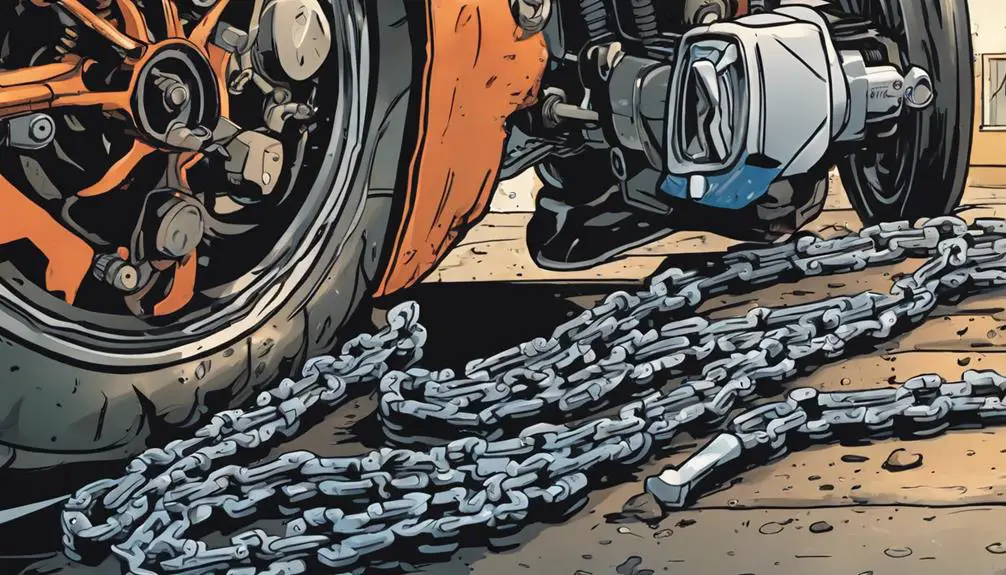
Keeping your motorcycle chain in top shape is vital for peak performance.
You'll want to establish a regular cleaning schedule, use the right lubrication methods, and guarantee proper tension adjustment.
Let's break down each of these essential techniques for effective chain maintenance.
Regular Cleaning Schedule
Regularly cleaning your motorcycle's chain not only extends its life but also guarantees a smoother ride. Dirt and grime can build up over time, causing unnecessary wear and tear. By making chain cleaning a part of your routine, you're not just protecting your bike; you're enhancing your freedom on the open road.
Here are a few tips to keep your chain in top shape:
- Choose the right time: Clean your chain after every few rides or whenever it looks particularly dirty. A little maintenance goes a long way.
- Use the right tools: Invest in a chain cleaning brush and a suitable cleaner. You'll be amazed at how much easier it's with the right gear.
Proper Lubrication Methods
After cleaning your motorcycle's chain, proper lubrication guarantees it operates smoothly and efficiently. To achieve this, choose a high-quality chain lubricant designed specifically for motorcycles. Avoid using WD-40 or other general-purpose oils, as they won't provide the protection your chain needs.
When applying the lubricant, position your bike on a stand so the rear wheel can rotate freely. This allows you to evenly coat the entire chain. Spray or apply the lubricant on the inside of the chain while you slowly rotate the wheel. This method assures the lube penetrates the rollers and links effectively.
After applying, let the lubricant sit for about 10-15 minutes. This allows it to settle and bond with the chain, forming a protective layer. Wipe off any excess with a clean cloth to prevent dirt accumulation.
Make it a habit to check your chain lubrication during your regular maintenance routine, ideally every 300-500 miles. Proper lubrication not only extends the life of your chain but also enhances your riding experience by assuring smooth power transfer. Keep your ride free and easy by giving your chain the care it deserves!
Tension Adjustment Guidelines
Proper chain tension is essential for ideal performance and safety, so it's important to check and adjust it regularly. An improperly tensioned chain can lead to poor handling, excessive wear, and potential failure, which can be dangerous.
Here are some simple steps to keep your chain in check:
- Inspect the chain regularly: Look for any signs of wear, rust, or damage, especially after a long ride.
- Use the proper tools: A chain tensioner tool or a ruler will help you measure the slack accurately.
When adjusting, aim for the middle of the recommended tension range. You want enough slack to allow for movement but not so much that it compromises your ride.
After making adjustments, it's important to recheck the tension after a short ride, as it may settle. Keep your chain in top shape, and you'll not only enjoy a smoother ride but also embrace the freedom of the open road with confidence.
Cooling System Checks
Checking your motorcycle's cooling system is vital to prevent overheating and guarantee peak performance. A reliable cooling system keeps your engine running smoothly, allowing you the freedom to ride without worry.
Start by inspecting the coolant level in the reservoir; it should be between the minimum and maximum marks. If it's low, top it off with the recommended coolant mixture.
Next, check for leaks. Look for any signs of coolant dripping from hoses or the radiator. If you spot any leaks, it's important to address them before they escalate into bigger issues.
Additionally, inspect the radiator for any debris or blockages that could hinder airflow. A clean radiator guarantees your engine stays cool, even in the heat of the ride.
Don't forget to check the condition of the hoses. They should be firm and free of cracks or bulges. If you notice any signs of wear, it's time for a replacement.
Regular Filter Replacements
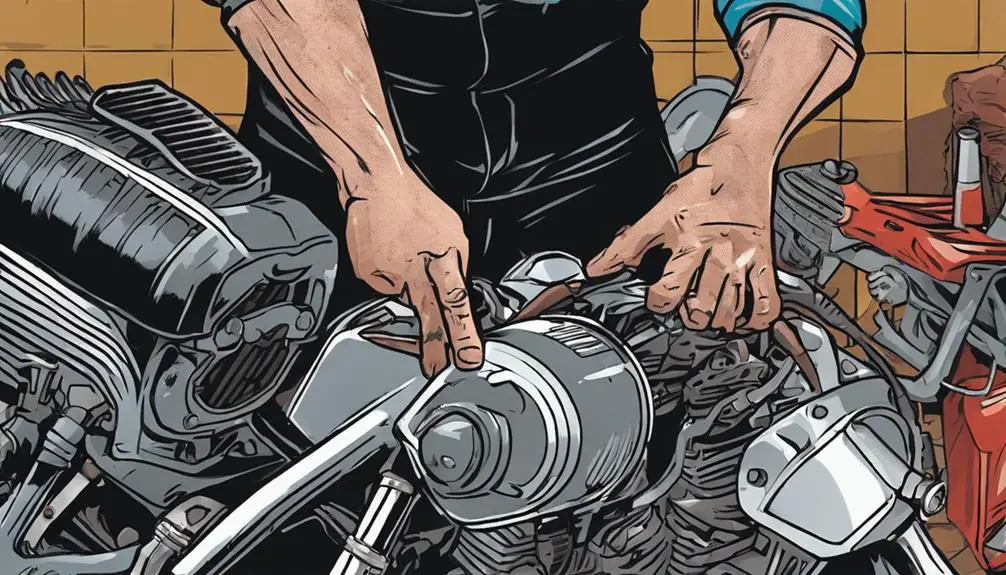
Regularly replacing filters is vital for your motorcycle's performance and longevity. Ignoring this task can lead to reduced efficiency and potential engine damage. You want your ride to be smooth and powerful, so make filter replacements a priority in your maintenance routine.
Here are some key filters to keep an eye on:
- Oil Filter: Change it during every oil change to keep your engine clean and running smoothly.
- Air Filter: Replace it every riding season or sooner if you ride in dusty conditions; a clean air filter guarantees peak airflow and performance.
Addressing Suspension Problems
Suspension problems can seriously affect your motorcycle's handling and comfort, so it's crucial to address them promptly. Start by checking your forks and rear shock for any signs of leaks or damage. If you spot oil on the forks, it means your seals might be worn out and need replacing. Don't wait—fixing this now can prevent bigger issues down the road.
Next, evaluate your ride height. If your bike feels too low or too high, it could indicate that your suspension settings are off. Adjust the preload to suit your weight and riding style. This simple tweak can enhance your control, giving you the freedom to tackle those winding roads with confidence.
Don't forget about checking your tires, either. Worn or uneven tire wear often signals suspension problems. Regularly inspect your tires and replace them as necessary to maintain that liberating ride you crave.
Frequently Asked Questions
How Often Should I Wash My Motorcycle?
You should wash your motorcycle every two to four weeks, depending on how often you ride and the conditions you encounter.
If you're cruising through mud or rain, you might need to clean it more frequently.
Keeping your bike clean not only maintains its appearance but also protects the finish and components from corrosion.
What Are Signs My Bike Needs a Tune-Up?
Did you know that a well-tuned motorcycle can improve fuel efficiency by up to 30%? If your bike's performance is lagging, you might need a tune-up.
Look for signs like rough idling, decreased acceleration, or unusual noises. If your bike's struggling to start or the exhaust smells off, it's time to check in.
Regular maintenance not only keeps you safe but enhances that liberating ride you crave. Don't ignore those signals!
Can I Use Car Oil in My Motorcycle?
You shouldn't use car oil in your motorcycle.
Motorcycle engines operate under different conditions and require oil formulated for their specific needs, including higher temperatures and more friction.
Car oil often lacks the additives that protect your bike's engine components.
Using the wrong oil could lead to poor performance and even engine damage.
Stick to the oil recommended in your owner's manual to keep your ride running smoothly and efficiently.
How Do I Store My Motorcycle for Winter?
When winter winds whisper, you'll want to properly prepare your motorcycle for hibernation.
First, clean it thoroughly to banish grime and grit.
Next, drain the fuel or add a stabilizer to prevent pesky problems.
Don't forget to disconnect the battery and cover your bike to shield it from dust and dampness.
Store it in a dry, cool place, and your ride will be ready to roar when spring returns!
What Should I Do if My Motorcycle Won't Start?
If your motorcycle won't start, don't panic.
First, check the fuel level—make sure you've got gas.
Then, inspect the battery; it might need a jump or replacement.
Look for any loose wires or connections.
If the starter isn't engaging, you might have a faulty relay.
Finally, consider the kickstand switch—if it's not in the right position, it can prevent starting.
Keep exploring these possibilities, and you'll get back on the road in no time!
Conclusion
By staying proactive with your motorcycle maintenance, you'll guarantee a smoother ride, enhance safety, and extend your bike's lifespan.
Regularly check your oil, inspect your brakes, and maintain your tires, just as you'd monitor your chain, coolant, and filters.
Addressing these common issues not only keeps your motorcycle in top shape but also gives you peace of mind on the road.
So gear up, stay vigilant, and enjoy every ride with confidence and comfort.